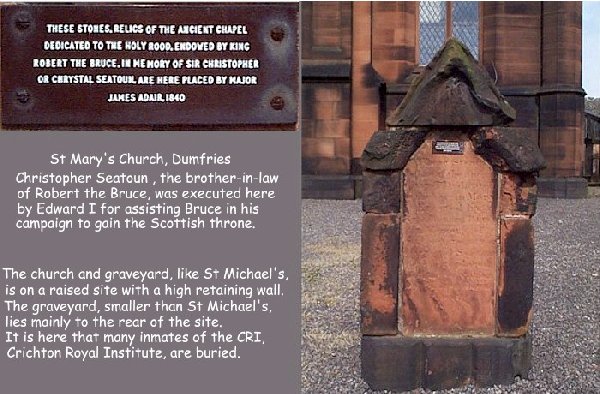
Chapel of Sir Christopher Seton's Burial
The former Chrystell's Chapel, now St. Mary's, Dumfries, Scotland.
Click photo for next
Long after the desertion of the Greyfriars’ Church, the missal service was continued in Sir Christopher’s Chapel. Sir Richard Maitland states, in his account of the Seton family, that he had heard mass in the building, and that the latter was standing undecayed in 1552. In the course of a few subsequent years its doors would be closed and its endowment be secularized. For more than a century the little chapel, when falling into ruins, looked forlorn yet picturesque, till nearly all that remained of it was carried away for defensive purposes during the Jacobite Rebellion of 1715. It has been conjectured that the eminence on which it was built, and which was the scene of Seton’s judicial murder, was the Tyburn of the Burgh: a supposition which receives support from a discovery of numerous human remains when, in 1837, the foundation was excavated of the edifice that now crowns the “Crystal Mount” – St. Mary’s Church. On that occasion, upwards of seventy skulls were dug up. Were any of these deserted “domes of thought” tenanted by the doughty warrior who, by saving Bruce at Methven, saved his country, and proved his patriotism in the more terrible ordeal of the scaffold?
In a paper by Mr. James Starke, on Sir Christopher’s Chapel, he says: “There is no reason to doubt but that the patriot Seton suffered at the common place of execution at that day . . . . It was the Tyburn of Dumfries, and here also, as tainted and polluted ground, all suicides were buried.” – Transactions of Dumfriesshire and Galloway Natural History and Antiquarian Society, vol. ii., p. 44. The questions must remain unanswered. Undoubted relics of the sacred building by which Seton’s memory was enshrined were, however, picked up whilst the present church was being founded; and these have been tastefully set up within an enclosure on the south side of the church. They constituted part of the beautiful east window, noticed by us in a former chapter, and bear the following inscription: - “These stones, the relics of the ancient chapel, dedicated to the Virgin Mary, erected by King Robert Bruce, in memory of Sir Christopher or Chrystal Seatoun, are here placed by Major James Adair, 1840.” [This inscription is erroneous. The chapel, as we have seen, was built by Lady Seton, and only endowed by her royal brother; and it was not dedicated to the Virgin, but, as the charter distinctly states, was “erected in honour of the Holy Rood.” Major Adair, who was a member of the kirk-session of St. Mary’s merits thanks for collecting and authenticating these relics of this interesting historical edifice.]